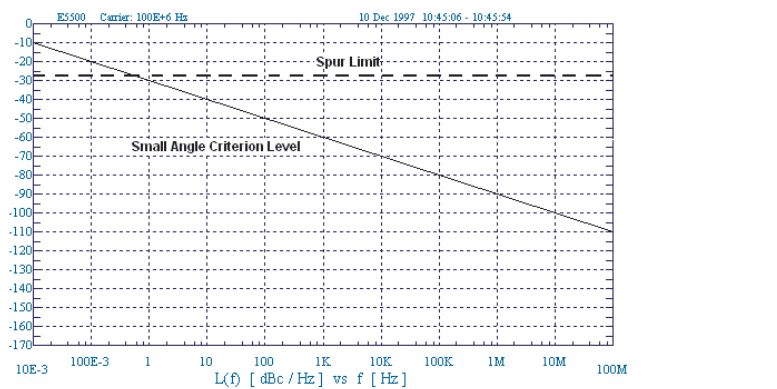User`s guide
Table Of Contents
- Title Page
- Contents
- Getting Started
- Introduction and Measurement
- Phase Noise Basics
- Expanding Your Measurement Experience
- Starting the Measurement Software
- Using the Asset Manager
- Using the Server Hardware Connections to Specify the Source
- Setting GPIB Addresses
- Testing the 8663A Internal/External 10 MHz
- Testing the 8644B Internal/External 10 MHz
- Viewing Markers
- Omitting Spurs
- Displaying the Parameter Summary
- Exporting Measurement Results
- Absolute Measurement Fundamentals
- Absolute Measurement Examples
- Residual Measurement Fundamentals
- What is Residual Noise?
- Assumptions about Residual Phase Noise Measurements
- Calibrating the Measurement
- Measurement Difficulties
- Residual Measurement Examples
- FM Discriminator Fundamentals
- FM Discriminator Measurement Examples
- AM Noise Measurement Fundamentals
- AM Noise Measurement Examples
- Baseband Noise Measurement Examples
- Evaluating Your Measurement Results
- Advanced Software Features
- Reference Graphs and Tables
- Approximate System Noise Floor vs. R Port Signal Level
- Phase Noise Floor and Region of Validity
- Phase Noise Level of Various Agilent Sources
- Increase in Measured Noise as Ref Source Approaches DUT Noise
- Approximate Sensitivity of Delay Line Discriminator
- AM Calibration
- Voltage Controlled Source Tuning Requirements
- Tune Range of VCO for Center Voltage
- Peak Tuning Range Required by Noise Level
- Phase Lock Loop Bandwidth vs. Peak Tuning Range
- Noise Floor Limits Due to Peak Tuning Range
- Tuning Characteristics of Various VCO Source Options
- 8643A Frequency Limits
- 8644B Frequency Limits
- 8664A Frequency Limits
- 8665A Frequency Limits
- 8665B Frequency Limits
- System Specifications
- System Interconnections
- PC Components Installation
- Overview
- Step 1: Uninstall the current version of Agilent Technologies IO libraries
- Step 2: Uninstall all National Instruments products.
- Step 3: Install the National Instruments VXI software.
- Step 4: Install the National Instruments VISA runtime.
- Step 5: Install software for the NI Data Acquisition Software.
- Step 6: Hardware Installation
- Step 7. Finalize National Instruments Software Installation.
- Step 8: System Interconnections
- Step 9: Install Microsoft Visual C++ 2008 Redistributable Package use default settings
- Step 10: Install the Agilent I/O Libraries
- Step 11: Install the E5500 Phase Noise Measurement software.
- Step 12: Asset Configuration
- Step 13: License Key for the Phase Noise Test Set
- Overview
- PC Digitizer Performance Verification
- Preventive Maintenance
- Service, Support, and Safety Information
- Safety and Regulatory Information
- Safety summary
- Equipment Installation
- Environmental conditions
- Before applying power
- Ground the instrument or system
- Fuses and Circuit Breakers
- Maintenance
- Safety symbols and instrument markings
- Regulatory Compliance
- Declaration of Conformity
- Compliance with German noise requirements
- Compliance with Canadian EMC requirements
- Service and Support
- Return Procedure
- Safety and Regulatory Information

126 Agilent E5505A User’s Guide
5
Absolute Measurement Fundamentals
4
Press the [[DEFINE TRACE]]
a
press the [[and the MATH FUNCTION keys.
Using the --> key on the RF analyzer, offset the marker by the PLL
bandwidth. Read the offset frequency and noise level indicated at the
bottom of the display. (If the noise level falls below the bottom of the
display, the marker reading is still correct.)
5
To increase the vertical scale
a
press [[VERT SCALE]]
b
press [[, DEFINE DB/DIV]], and enter 20 dB.
6
Compare the average noise level at the PLL bandwidth offset to the small
angle criterion level shown on the graph in Figure 82. The average noise
level of the signal must remain below the small angle line at all offset
frequencies beyond the PLL bandwidth. (The small angle line applies only
to the level of the average noise. Spur levels that exceed the small angle line
do not degrade measurement accuracy provided they do not exceed
—
⋅
40 dBc.)
7
Continue moving the marker to the right to verify that the average noise
level remains below the small angle line.
8
Increase the span by a factor of ten by selecting FREQ and DEFINE SPAN.
Continue comparing the noise level to the graph.
9
Continue to increase the span width and compare the noise level out to
100 kHz. (If the noise level exceeds the small angle line at any offset
frequency beyond the PLL bandwidth, note the offset frequency and level of
the noise. Use the graph in Figure 83 on page 127 to determine the Peak
Figure 82 Graph of small angle line and spur limit










